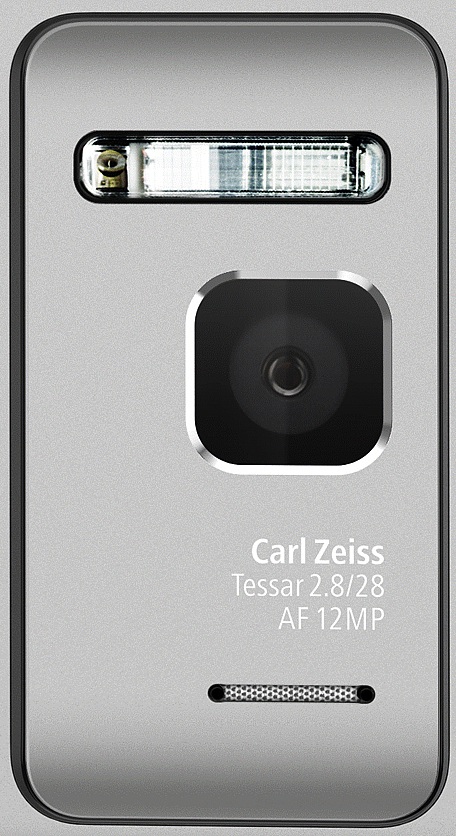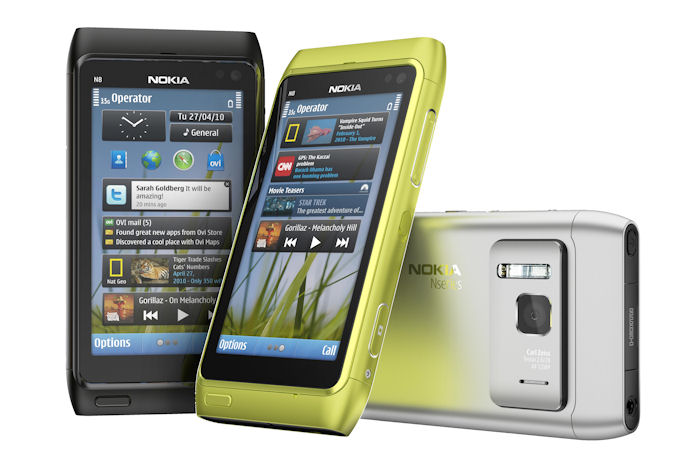 Let's run through the camera specs and features in more detail. As already mentioned, the N8's camera is one of the largest (if not the largest, optically) ever fitted to a 'phone'.
Let's run through the camera specs and features in more detail. As already mentioned, the N8's camera is one of the largest (if not the largest, optically) ever fitted to a 'phone'.
The stills camera features:
- Xenon flash - the only camera flash technology worthy of the word 'flash' - the last couple of years of poor LED-lit party shots can be safely forgotten - see my feature on this. You may also remember Nokia's own Xenon versus dual LED comparisons, showing that the N86's variable aperture lens can, with the LED, produce comparable results to Xenon in the right situations. All good stuff, but most low light shots aren't in 'right' situations: people will be moving and you'll need a lot more than sheer illumination - you'll need something that shoots far more quickly, so that your subjects are frozen in time. Hence Xenon. No offense, N86...!
- Very large sensor (rated at '1/1.83"' optical format). Previously (e.g. in the N86) Nokia had been using the smaller '1/2.3"'. Many compact digital cameras are still currently using 1/2.3" in fact, putting the N8 ahead of these in terms of sensor, even if not in terms of lens size and optics (phones have to be somewhat thinner, after all!). Individual sensor pixels are apparently 47% bigger than those in competing 12mp camera phones.
- Carl Zeiss 2.8/28 optics (the '28' bit refers to equivalent 35mm focal length - don't worry about it). The protective glass has an anti-reflection coating, plus is toughened to resist scratching (I'm thinking Gorilla glass here, but don't know for sure). Nokia had considered including a physical cover, as on the N82, N95 and N86, but rejected the idea because of bulk (another 3mm would be needed, i.e. a bulge) and, interestingly, because more and more software is requiring camera access (e.g. augmented reality) and the apps need the picture immediately, without a need for the user to remember to retract a slider.
- Fixed aperture lens. The (experimental) variable aperture lens used in the N86 8MP added extra bulk, but the N8 is claimed to have even better low light performance than the N86 (even ignoring the Xenon flash), thanks to a more sensitive sensor. The problem of shooting in bright light (e.g. direct sunlight), which was handled spectacularly on the N86 by reducing aperture size, is handled on the N8 equally as effectively with a ND (Neutral Density) filter that automatically slides into the optics when light levels exceed a certain threshold.
- Extra software enhancements. With the larger sensor and better optics, there was less need for Nokia's traditional noise reduction algorithms, with the result that more of the phone's processing power could be applied to real time image handling. Red eye reduction is implemented as well as on standalone digital cameras and face detection is much faster than on the N86. Auto-focus times are also significantly better than on anything seen so far from Nokia, "reducing auto focus on a typical still image to about around half a second or less". Shutter release latency is also improved and is now down to "about 150 milliseconds".
The video camera features:
- Stereo audio recording - one mike on 'front', i.e. camera side, plus one on the other face (under the display) of the phone - the normal one used for voice calls. By recording from both mikes and applying noise cancellation algorithms, Nokia are confident the system will help to reduce wind noise and also control the recording levels in continuous harsh noise environments e.g. recording live music in a bar. You can also use this for better narration whilst filming, with better sound balance between videographer and subject and with stereo separation.
- The microphones used are digital, i.e. the same as those used in the N86 8MP, and (should) produce incredibly crisp results at a wide variety of sound levels. Viewers often say that they can't believe I'm using a phone's built-in mike in The Phones Show, but it's all true. And, yes, very impressive, aurally.
- Focussing is 'fixed' in that it's outside of the user's control and automatically set with a new Active Hyperfocal Distance system, with the f2.8 aperture giving a genuine depth of field of 60cm to infinity, depending on light conditions - essentially the software works out what to set the 'preset focus' to in order to get maximum depth of field going back to infinity. I've gone over the pros and cons of the various approaches to video focus in mobile phone cameras before - no focussing and you get blurry subjects; initial focus and you get blurry subjects when the composition changes; continuous auto-focus and you have to wait while focussing gets fixed whenever you change the subject. Suffice it to say that Nokia's compromise approach here, an extension of the preset focus used in the N82, N95 and N86, is just as valid as Sony Ericsson's or Samsung's approaches in their own HD video phones, in my opinion.
- HD video capture resolution (1280 by 720 pixels). Nokia has now posted a sample of this, which looks pretty impressive considering that there's no focussing going on. The sample has a canned audio track, mind you - rest assured I'll test this properly when the time comes.
- The same intelligent digital zoom in video mode as the N86 - no blockiness - almost as good as optical zoom. Again, the whole (large, 4000x3000 pixel) sensor is used for video capture, with downscaling to the desired resolution happening in custom electronics hardware. Depending on the resolution being shot at, up to 3x zoom should be handled without undue pixellation (there's a 'hard' limit at 3x, to stop people trying to zoom further and starting to see degraded results). See here for a demo of this working on the N86. The system works surprisingly well - in low light, it's even superior to optical zoom, since the latter involved more glass optics, reducing the light that gets to the sensor. Nokia don't push this improved zoom facility in any of their N86 or N8 marketing, but it's something well worth noting.
Note also that here are touch gestures to allow switching between 16:9 and 4:3 aspect ratios while filming, with a double tap gesture for instant zooming from one end of the 'lossless' digital zoom to the other.

It's fair to say that Nokia believe the N8 to be the best camera-toting smartphone in the world. Maybe even the best camera-toting phone, period. The features listed above, for both stills and video, seem very convincing, although of course until we get our hands on production hardware we can't prove the claims outright. Allied to the other N8 firsts in the Nokia world (Symbian^3, 256MB RAM, unibody shell, OLED screen, capacitive touch, etc.), the Nokia N8 is destined to stay the hottest review device that All About Symbian has seen for a long time.
Steve Litchfield, All About Symbian, 28 April 2010
